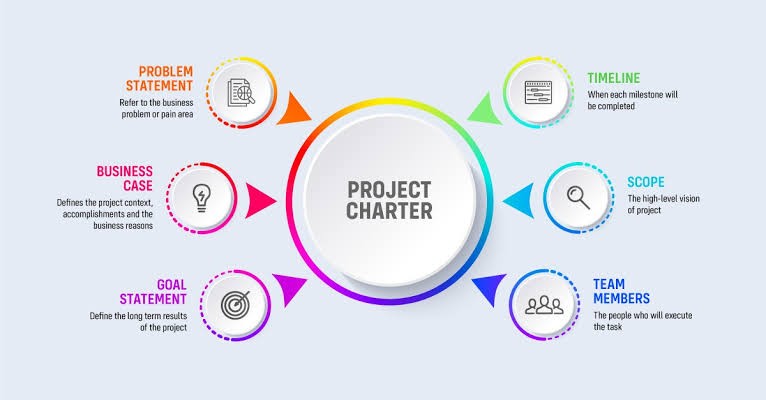Introduction
A project charter is the cornerstone of any successful project, serving as the formal document that authorizes the project’s existence and outlines key details such as objectives, scope, and stakeholders. In IT project initiation, developing a comprehensive project charter is crucial for setting the foundation for success, providing clarity, and aligning all stakeholders with the project’s goals. In this blog post, we’ll explore the steps to create a detailed project charter, discuss why it’s an essential piece of project documentation, and provide practical tips for IT Project Managers.
What is a Project Charter?
A project charter is a high-level document that formally launches a project. It defines the purpose, scope, objectives, and stakeholders, while also giving the project manager the authority to use resources. This document is essential because it provides a shared understanding of what the project is aiming to achieve, the boundaries within which it operates, and the responsibilities of each key player involved.
Benefits of a Comprehensive Project Charter
A well-prepared project charter is invaluable for several reasons:
- Clarity of Purpose: It ensures that everyone involved understands why the project exists and what it aims to achieve.
- Alignment: It aligns stakeholders by documenting the project’s goals, reducing the likelihood of misunderstandings.
- Authority: It formally authorizes the project, empowering the project manager to allocate resources and make decisions.
- Reduced Risks: By outlining key project details, the charter helps identify potential risks early, leading to better risk management.
Steps to Develop a Project Charter
- Define the Project Purpose and Objectives
- Start by defining the project purpose—what problem is the project solving, or what opportunity is it addressing? This should be concise and clear, providing the “why” behind the project.
- Outline the project objectives. Objectives should be specific, measurable, achievable, relevant, and time-bound (SMART). For example, “Develop and implement a new CRM system by Q4 to enhance customer management efficiency.”
- Establish Project Scope
- The project scope is a critical element of the project charter, outlining what is included and, importantly, what is not included in the project. This helps in avoiding scope creep during the project’s lifecycle.
- Clearly defining the boundaries of the project ensures everyone has a shared understanding of what deliverables are expected.
- Identify Key Stakeholders
- Identify all key stakeholders involved in the project. These are individuals or groups who have an interest in the project’s success or may be affected by its outcome.
- List stakeholders such as the project sponsor, project team members, clients, and any external vendors. Understanding who your stakeholders are and their roles helps in effective communication and engagement throughout the project.
- Outline Roles and Responsibilities
- Assign specific roles and responsibilities within the project. The project manager’s role, the responsibilities of team members, and the authority of stakeholders should be clearly documented.
- For IT projects, this could mean outlining the responsibilities of developers, analysts, testers, and external partners.
- Define High-Level Requirements
- The project charter should include high-level requirements that outline what needs to be done to achieve the project’s objectives. These requirements set the foundation for more detailed planning during later phases.
- For example, in an IT project, high-level requirements might include system integration, data migration, and user interface development.
- Establish Milestones and Timeline
- Include key milestones and a high-level timeline for the project. These milestones act as checkpoints that help track progress and ensure that the project is on track.
- Milestones could be phases like “Complete system design by Q2” or “Begin user acceptance testing in Q3.”
- Determine Project Resources and Budget
- Outline the estimated resources and budget required for the project. This may include personnel, technology, tools, and any other resources necessary for successful execution.
- Documenting the budget early helps prevent surprises later and ensures that funding is secured to meet project needs.
- Identify Risks and Assumptions
- Identify potential risks that could impact the project and document initial mitigation strategies. Early risk identification is vital for effective risk management.
- Include any assumptions that the project relies upon. For example, you may assume that certain software tools will be available when needed or that team members will have the necessary skills.
- Approval and Sign-Off
- The project charter should be approved and signed by key stakeholders, including the project sponsor. This formal approval process provides the authority to move forward and ensures that everyone involved is committed to the project’s success.
Key Components of a Project Charter
To summarize, a comprehensive project charter should include the following components:
- Project Purpose and Objectives
- Project Scope
- Key Stakeholders
- Roles and Responsibilities
- High-Level Requirements
- Milestones and Timeline
- Resources and Budget
- Risks and Assumptions
- Approval and Sign-Off
Best Practices for Creating a Project Charter
- Keep It Concise: A project charter should be clear and concise. Aim to provide enough detail for clarity without overwhelming readers with unnecessary information.
- Involve Stakeholders: Involve key stakeholders early when creating the charter. This ensures their expectations are managed and their input is considered.
- Make It a Living Document: While the charter is primarily a document for initiation, it may require updates if significant changes occur during the project. Keep it flexible where necessary.
Conclusion
A well-crafted project charter is an essential piece of project documentation for IT project initiation. It sets the stage for success by providing a clear understanding of the project’s purpose, scope, objectives, and the roles of all stakeholders. By developing a comprehensive project charter, IT Project Managers can ensure that the project starts on the right track, with clear expectations, well-defined roles, and a shared commitment to success.
Ready to enhance your project initiation skills? Stay tuned for more insights and guides on effective project management techniques!
Keywords: Project charter, Project documentation, IT project initiation.


